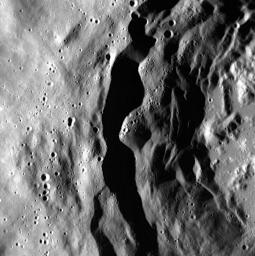
|
Young Terraces
- Click the image above for a larger view
- Full-Res JPEG (1020 x 1024) (160.3 kB)
- Full-Res TIFF (1020 x 1024) (1.0 MB)
Caption:
MESSENGER captured this image as the spacecraft sped roughly 720 km above the surface. The wall of a 45-km-diameter crater shows well-preserved terraces , common for complex craters that are geologically young. Keep in mind though, that the last billion years can be taken to mean "relatively young" when talking about Mercury's surface!
This image was acquired as part of the NAC ride-along imaging campaign. When data volume is available and MDIS is not acquiring images for its other campaigns, high-resolution NAC images are obtained of the surface. These images are designed not to interfere with other instrument observations but take full advantage of periods during the mission when extra data volume is available.
Date acquired:
January 13, 2015
Image Mission Elapsed Time (MET):
63465288
Image ID:
7788113
Instrument:
Narrow Angle Camera (NAC) of the Mercury Dual Imaging System (MDIS)
Center Latitude:
54.58°
Center Longitude:
314.68° E
Resolution:
18 meters/pixel
Scale:
This image is roughly 18 km (11 miles) across
Incidence Angle:
66.3°
Emission Angle:
11.7°
Phase Angle:
78.0°
Background Info:
The MESSENGER spacecraft is the first ever to orbit the planet Mercury, and the spacecraft's seven scientific instruments and radio science investigation are unraveling the history and evolution of the Solar System's innermost planet. During the first two years of orbital operations, MESSENGER acquired over 150,000 images and extensive other data sets. MESSENGER is capable of continuing orbital operations until early 2015.
For information regarding the use of images, see the MESSENGER image use policy .
Cataloging Keywords:
| Name | Value | Additional Values |
|---|---|---|
| Target | Mercury | |
| System | ||
| Target Type | Planet | |
| Mission | MESSENGER | |
| Instrument Host | MESSENGER | |
| Host Type | Orbiter | |
| Instrument | Mercury Dual Imaging System (MDIS) | |
| Detector | Narrow Angle Camera (NAC) | |
| Extra Keywords | Crater, Grayscale, Radio | |
| Acquisition Date | ||
| Release Date | 2015-02-06 | |
| Date in Caption | 2015-01-13 | |
| Image Credit | NASA/Johns Hopkins University Applied Physics Laboratory/Carnegie Institution of Washington | |
| Source | photojournal.jpl.nasa.gov/catalog/PIA19195 | |
| Identifier | PIA19195 | |
